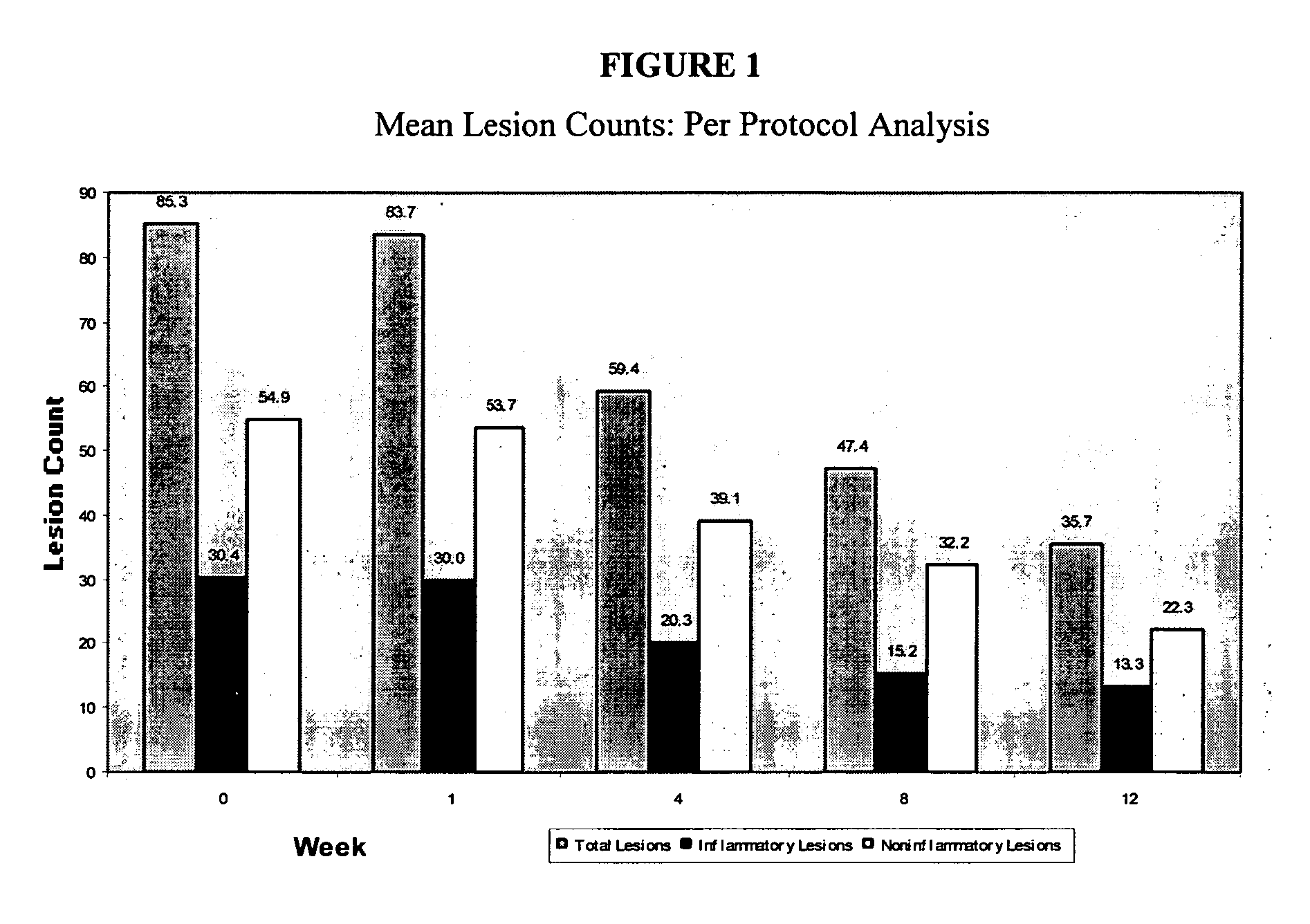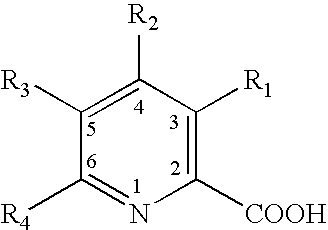Compositions and methods useful for treatment of acne
a technology for acne and compositions, applied in the field of compositions and methods for treating or controlling acne, can solve the problems of reducing the sensitivity of i>p. acnes /i>, limiting the therapeutic range, and reducing clinical benefits
- Summary
- Abstract
- Description
- Claims
- Application Information
AI Technical Summary
Benefits of technology
Problems solved by technology
Method used
Image
Examples
example 1
Antimicrobial Susceptibility Testing of Propionibacterium acnes in Picolinic and Fusaric Acids by the Agar Dilution Method.
[0037] The purpose of this study was to determine the Minimum Inhibitory Concentration (MIC) of Picolinic acid and fusaric acid that would visibly inhibit the growth of Propionibacterium acnes. The procedure for this study was based on “NCCLS Methods for Antimicrobial Susceptibility Testing of Anaerobic Bacteria; Approved Standard—Fifth edition” and used the agar dilution method.
[0038] Picolinic acid and fusaric acid were a white crysalline material and a white powder, respectively. Stock solutions of the test substances were prepared the day of testing in ABC reagent water that had been autoclaved for sterilization. A stock solution of Picolinic acid was prepared by adding 2.010 g of the test substance to 200 mL of ABC reagent water to make a concentration of 10 mg / mL. The stock solution of Fusaric acid was prepared by adding 0.5000 g of test substance to 100...
example 2
[0056] Example 2 demonstrates the safety and the potential efficacy of NV-02 in the topical treatment of mild to moderate acne vulgaris. [0057] Name of Finished Product: 10% Picolinic Acid Gel (NV-02) [0058] Name of Active Ingredient: Picolinic Acid (PCL-016) [0059] Study period: 3 months [0060] Date of first enrollment: Oct. 22, 2002 [0061] Date of last completed: May 2, 2003 [0062] Methodology: Open label study [0063] Number of patients (planned and analyzed): 15 patients planned, 20 enrolled, 15 completed. [0064] Diagnosis and main criteria for inclusion: mild to moderate acne vulgaris [0065] Test product, dose and mode of administration, batch number: NV-02 applied twice daily to affected areas of the face; Novactyl lot number 155 [0066] Duration of treatment: twice daily for 3 months [0067] Criteria for evaluation: [0068] Efficacy: Total lesion counts, inflammatory lesion count, non-inflammatory lesion count, and Cunliffe's grade, FDA scale [0069] Safety: Adverse events, PCL-0 ...
example 3
[0102] It is widely accepted that the ability of a test product to produce reductions in P. acnes colony counts on the skin of healthy volunteers with little to no acne reliably predicts the ability of that test product to reduce P. acnes colony counts and treat acne in patients with acne. (Leyden, James L., The Evolving Role of Proprionibacterium Acnes in Acne, SEMINARS IN CUTANEOUS MEDICINE AND SURGERY, 20(3):139-143, September 2001.) Twenty normal, healthy adult males and females between the ages of 19 and 53 years were selected to evaluate NV-02 for its ability to reduce P. acnes colony counts on the skin. The volunteers who were selected for the study were essentially free of acne but had a high degree of fluorescence of the facial skin under a Wood's lamp examination indicating the presence of high levels of P. acnes. They were carefully screened to ensure that none were using any form of topical or systemic antibiotics within 4 weeks prior to enrollment. They were given a non...
PUM
| Property | Measurement | Unit |
|---|---|---|
| concentration | aaaaa | aaaaa |
| concentration | aaaaa | aaaaa |
| concentrations | aaaaa | aaaaa |
Abstract
Description
Claims
Application Information
 Login to View More
Login to View More - R&D Engineer
- R&D Manager
- IP Professional
- Industry Leading Data Capabilities
- Powerful AI technology
- Patent DNA Extraction
Browse by: Latest US Patents, China's latest patents, Technical Efficacy Thesaurus, Application Domain, Technology Topic, Popular Technical Reports.
© 2024 PatSnap. All rights reserved.Legal|Privacy policy|Modern Slavery Act Transparency Statement|Sitemap|About US| Contact US: help@patsnap.com










